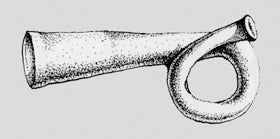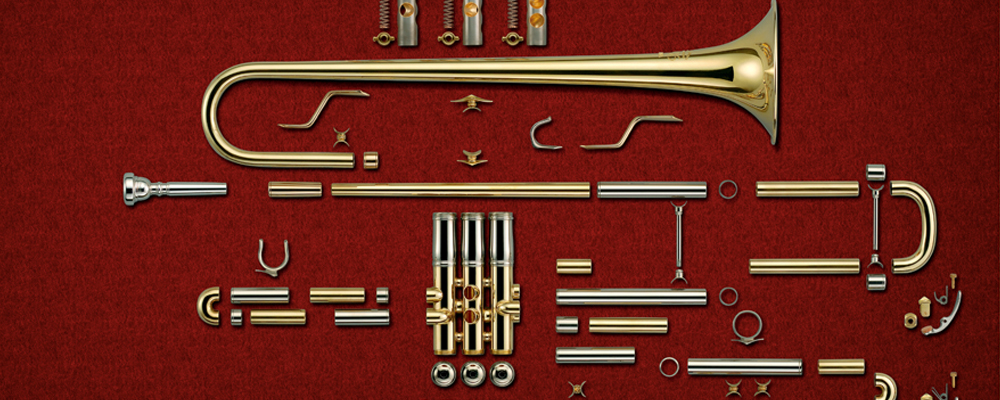
Trumpet Learn More
Share

The Structure of the Trumpet
Learn the parts of the trumpet
The trumpet is comprised of the following parts:

The Structure of the Trumpet
How does the trumpet generate sound?
Sound is produced by buzzing the lips!
The trumpeter produces sound from the trumpet by buzzing his lips. That said, it is in fact the metallic mouthpiece that produces the sound. There are various different mouthpiece shapes-a mouthpiece with a deep cup will produce a mellower sound, while a mouthpiece with a shallower cup will produce a bright, piercing sound.
Mouthpieces are made of brass or silver (among other materials), and trumpeters choose a mouthpiece according to their personal preference. An individual trumpeter may use a number of different mouthpieces, according to the key of the piece or the particular timbre he wishes to produce.

Mouthpieces with cups of different size and depth

Cross-sectional diagram of the mouthpiece of a trumpet
Trumpet
The trumpet or cornet is the smallest and highest member of the brass family. The sound is made by buzzing your lips into the mouthpiece. Trumpet and Cornets are very similar; the trumpet is a bit longer and more slender than a cornet. The real difference has to do with the way the tubing of the instrument flares. A cornet is more cone shaped or conical than a trumpet.
The trumpet is played with the right hand on top of the instrument with the first three fingers resting on the valves. The left hand holds the instrument with the fingers wrapped around the middle of the valves.
There are many types of trumpets and cornets, the most popular is Bb trumpet and the starting place for a beginner. There is als a “C” trumpet, “D” trumpet or even a piccolo trumpet. The most common version is a Bb (“B” flat) trumpet or cornet. All beginning trumpet players should start on a Bb instrument.
The trumpet is certainly one of the most popular instruments for young players. Since lots of other students will choose the trumpet, there will be more competition with other players.
The trumpet is used in many types of settings including: bands, symphony orchestras, jazz groups and small instrumental groups. It often is the solo line in these groups.
How is a scale played?
On the trumpet the pitch of notes is principally varied by using the valves to change the length of the tube.
In general, the longer the tube, the lower the note. The structure of the trumpet enables the note to be lowered by one tone by pressing the first valve, by a semitone by pressing the second valve, and by one and a half tones by pressing the third valve.
The first valve lengthens the trumpet's tube by 160 mm, the second by 70 mm, and the third by 270 mm. These are just the right lengths for altering the pitch by the required interval.
For example, the valves are operated as follows in order to play the notes of the scale:


To change from G to F, the trumpeter presses the first valve, which lowers the pitch by one tone. To change from G to E, he presses the first and second valves, since E is one and a half tones below G. To change from G to D, he presses the first valve (which lowers the pitch by one tone) and the third valve (which lowers the pitch by one and a half tones), since D is two and a half tones below G.
View a video of a scale being played
Playing a scale
Why do C, G, and High C have the same fingering?
On the trumpet the fingering to operate the valves is the same for C, G, and High C. In other words, the length of the tube is the same and the pitch is varied by blowing the instrument in a different manner. This is because a property of sound known as the harmonic series allows notes to be distinguished by blowing in a different manner when the tube length is the same.
The following figure summarizes the relationship between valve operation and the note produced. Even when the valves are pressed in an identical fashion, several different notes can be produced. How can this be so?
Harmonic series produced when the valves are pressed
-
No valve pressed

-
First valve

-
Second valve

-
First valve and second valve

-
Second valve and third valve

-
First valve and third valve

-
All valves pressed

The various combinations of the trumpet's three valves allow a complete chromatic scale to be played. In addition, a single note can be produced using several different fingerings. For example, a high C can be produced without pressing any of the valves, by pressing the first and second valves, or by pressing the first and third valves.
Controlling the pitch using the slides
The triggers that the trumpeter hooks his fingers around are not simply designed to make the instrument easier to carry. The trumpeter controls the pitch of the note by using his left thumb to slide the first slide and his left ring finger to slide the third slide. This is why the instrument is fitted with these triggers.
Pressing the valves on the trumpet does not necessarily produce the right note. The valves can produce an approximation of the note; however, the trumpeter must use his mouth or the slides to make the necessary fine adjustments.
See video clips of adjusting the pitch by sliding the rings
Example of pitch adjustment (as seen from right)
Example of pitch adjustment (as seen from left)

How to Play the Trumpet
Techniques for playing the trumpet
Blowing techniques
Take a deep breath. Then, with your lips lightly closed, steadily exhale.
* Take care not to puff out your cheeks, and to keep your lips in the same lightly closed position.
Example of blowing technique
How to blow into the mouthpiece
With the mouthpiece placed at the center of your lips, take a deep breath, and then steadily exhale. If your lips vibrate as the instrument emits a honking sound, you're doing well.
Example of how to blow into the mouthpiece
How to hold the trumpet
With the trumpet supported firmly in your left hand, relax your shoulders, and position your right hand on the instrument without applying force.
* Take care with the position of your thumbs.


As seen from the trumpeter's position
* Take particular care with the position of your thumbs.

As seen from the side

As seen from the front

